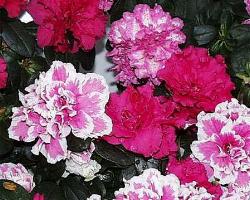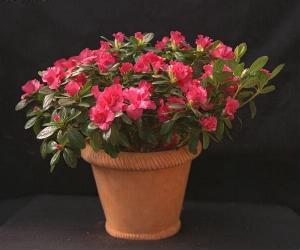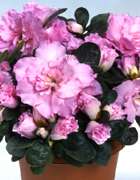|
Plants
for your home
(By Mary Efanti)
Azalea "Rhododendron"
 Origin and
Description Origin and
Description
Azaleas are native to the cool mountainous regions of
Japan, China, and India, which gives a clue to their care preferences. In the wild they
can grow to very large shrubs; cultivated forms are sometimes sold as standard
trees - with the plants on top of long trunks. A tremendous number of species and horticultural varieties are
available, many of which may be grown as pot plants. Extremely popular
houseplants,
azaleas are great value if given the correct care and conditions.
The azalea per se is hard to describe, as it may be a tiny 8"
spreading groundcover, or a 20' shrub. There are, in fact, more than 3000
different species, hybrids and cultivars of Rhododendron grown in the U.S.
alone. In any case, the azaleas are woody stemmed shrubs, prized for their
characteristic, usually prolific, often fragrant, trumpet shaped flowers. These
may be only 1/2", or more than 4" across. They come usually in shades
of pink, white, purple, orange and red, and may be freckled, variegated, single
or double. Many azalea varieties cultivated for landscape use are evergreen, but
there are plenty of deciduous ones too. Azaleas are rhododendrons, but all
rhododendrons are not azaleas. The common names are often interchanged, but some
would restrict "azalea" to those species whose flowers have 5 stamens
and use "rhododendron" for the species with 10 or more stamens.
 Care Care
Choice
Potted azalea plants are usually purchased at Easter when
they are a mass of buds and flowers. The garment of color is retained for weeks
if the plant is kept constantly moist. Most people have a particular color in mind when they
buy azaleas. One way to guarantee the color you want is to buy flowering plants.
You will be sure to get the right color, and if you are buying several you can
see if they match or blend. To get the most impact, set out blocks or sweeps of
the same selection. Ten types scattered across the front of your house will be
colorful but chaotic. Position When choosing the best spot to
plant, take the
sun into account. Azaleas like plenty of morning light. However, avoid areas
that get midday or hot afternoon sun--plants in full sun are susceptible to
lacebugs and spider mites. Consider the size of your plants. Not all azaleas are
low-growing shrubs. Don't crowd new plants together; space
them for the future, not for instant effect.
 Soil Soil
Azaleas need acid soil. Adding plenty of leaf
mold, peat moss, or bark
can help create the ideal environment. This is particularly important if you're
placing the plants near your home's foundation, where lime can leach out of the
concrete and neutralize acid soils. Limestone gravel used for drainage around
your home can also cause soil to be too alkaline.In alkaline soils, you may want to try
growing a few specimens in containers.
Fertilising
Immediately after flowering in Spring is the best time to fertilise with an
Azalea fertiliser.
Moisture.
Avoid planting azaleas near downspouts or areas that stay
damp. In heavy clay soil, plant them almost on top of the ground, building soil
up on the sides of the root ball. It is important to mulch Azaleas to keep in the moisture - a new mulching
material should be added after fertilising. Pine needles, oak leaves, shredded
bark, leaf mould all about 5cm thick, is quite good mulch and keeps the moisture
around the roots of the plant.
Watering
During dry spells soak them thoroughly every 7 to 10 days, and be sure that the
water reaches all the way to the bottom roots.
Planting in clay.
Dig a hole as deep as the root ball and twice as
wide. Add soil enriched with organic matter to the hole so that the top of the
root ball will sit 4 inches above ground level. Place the root ball in the hole,
and build up the soil on the sides. Planting high gives the shrub the drainage
it needs, but you will need to water frequently.
Pruning
Pruning is not important, but if one wants to shape the plants, immediately
after flowering is the best time.Avoid the urge to shear your plants into round balls or
other geometric forms. Azaleas look best when allowed to grow to their natural
mounded shape. Limit pruning to removing long, stray branches. Older plants that
have become leggy may benefit from pruning branches from the main trunk in
staggered lengths. If you have to prune hard every year, you probably have the
wrong azalea for that location, or your plants are too close together.
Propagation
Azaleas are grown from seed and propagated by stem
cuttings.
The amateur gardener will not have much success in increasing his stock by
either method. It is better to buy new plants, as they are needed.
Pest Control
Azaleas have few pests and diseases. Seek advice from your local nursery before
using a fungicide, pesticide or herbicide.
Concern
Don't worry when a few leaves turn yellow and drop
off, especially in the fall. All evergreens drop some leaves during the year. If
autumn is mild, azaleas will often bloom. There is nothing you can do to prevent
this. Enjoy the fall blooms, because flowering could be sparse the following
spring.
Mary Efanti
[email protected]
|
